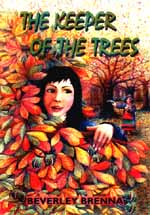|
________________
CM . . . .
Volume VII Number 8 . . . . December 15, 2000
excerpt: A figure was moving slowly across the grass up ahead. Elizabeth saw the layers of skirts lifting in a quick breeze that seemed to come out of nowhere. Maud suddenly bent down and ran her hands along the grass. The gate rose under her touch, gleaming in the moonlight. The old woman opened it and one of the horses cantered through into the garden. He raced away, then sidled back, shying when he got close to Maud and dashing away again. "Come along, now, Shakespeare," she told it firmly. "I know your name and you know mine." The dark brown horse tossed his head and took a run at the gate, but Maud crouched in his way. "You've got a job to do first, young 'un."Foreign experiences are the sum of 12-year-old Elizabeth's life when she moves from Canada to London, England. School is nerve racking, and she is friendless. She is attracted to and befriends a mysterious, homeless woman who stays in the huge park by Elizabeth's apartment. Maud reveals to Elizabeth that the tiny horseshoe shapes on the chestnut trees' bark are made by tiny little horses that live in the Otherworld and that come each spring to ensure that the chestnut trees bloom. Maud, as keeper of the trees, is responsible for opening and closing the gate to the Otherworld, and ensuring the horses do their job and return home. When Maud falls ill, it is up to Elizabeth to ensure the safety the horses and the trees. As she endeavors to fulfill her duties, Elizabeth encounters uncooperative horses, people intent on capturing the horses, and friendship, as well as a developing sense of belonging. Beverly Brenna bravely moves beyond the usual theme of finding one's place in the world. Through Maud's conversations with Elizabeth, the horses activities and a subplot involving an asthmatic boy whom Elizabeth knows, Brenna introduces the concept that all life is interrelated and interdependent. Brenna uses the same device of conversations and the actions of the Hunter, who is intent on capturing the horses, to present the idea that good and evil coexist in our world. Unfortunately, the early development of these themes is possibly too subtle for adolescent readers, and she delays the introduction of the Otherworld and its importance until the second third of the novel. The two subplots dealing with the asthmatic boy and her father seem disjointed from the main action until the end of the story. The pacing of this novel is uneven; events move quite slowly at the beginning and rapidly at the end. Brenna's text is rife with delightful imagery. Unfortunately, the wonderful poetry that introduces each chapter and flows from the lips of Maud may be as confusing to adolescent readers as it is to Elizabeth when she first hears it. The Keeper of the Trees will especially appeal to grade five and six girls who love horses and/or fantasy. Recommended. Kathleen Kirk is the teacher-librarian at Linden Meadows School in Winnipeg, MB.
To comment on this title or this review, send mail to cm@umanitoba.ca.
Copyright © the Manitoba Library Association.
Reproduction for personal use is permitted only if this copyright notice
is maintained. Any other reproduction is prohibited without
permission.
Published by
TABLE OF CONTENTS FOR THIS ISSUE - December 15, 2000.
AUTHORS |
TITLES |
MEDIA REVIEWS |
PROFILES |
BACK ISSUES |
SEARCH |
ORDER |
CMARCHIVE |
HOME
|
